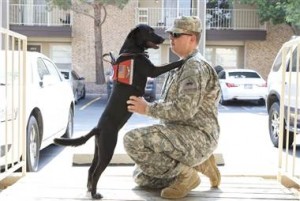PTSD in Military Working Dogs
 In my new release, MEN UNDER FIRE, Sgt. Nick Welby isn’t the only veteran returning home from Afghanistan with PTSD. His partner Talley, a bomb-sniffing canine, is also struggling to overcome Post-traumatic Stress Disorder.
In my new release, MEN UNDER FIRE, Sgt. Nick Welby isn’t the only veteran returning home from Afghanistan with PTSD. His partner Talley, a bomb-sniffing canine, is also struggling to overcome Post-traumatic Stress Disorder.
Nick and Talley are strong characters in their own right and well-suited to the perilous plot in this story, but as an avid dog-lover, there was deeper motivation behind the creation of these two characters. I wanted to raise awareness about the struggle many of our two-legged and four-legged veterans face when they return home from active duty.
PTSD has become a well-known condition in the decades following military action in Iraq and Afghanistan. Both human and canine veterans require intensive support, therapy and treatment in order to manage the symptoms of PTSD. For dogs, these symptoms may include:
- Extreme fearful or emotional reactions
- Aggression
- Hyper-vigilance
- Anxiety
- Physical behavior such as panting, pacing, sleep issues
Researchers, including psychiatrists, statisticians and veterinary behaviorists, are finding anecdotal evidence that indicates PTSD can affect service animals much like it impacts humans. Dogs who are identified as having PTSD may receive medication in addition to conditioning/behavior modification to unlearn a PTSD behavior Approximately 50 percent of these dogs return to active duty, with the remainder being reassigned, retired or adopted out.
Not everyone is convinced “canine PTSD” is a real issue. It doesn’t matter what label or title is applied to the skittish, stressed out behavior exhibited by dogs returning from active military duty. What does matter is making sure all of our veterans–human and canine–receive the care, support and respect they need to return to a happy, fulfilled life. For more information, check out these resources:
Canine PTSD Blog
Integrative Veterinary Car Journal
Veterinary Practice News











